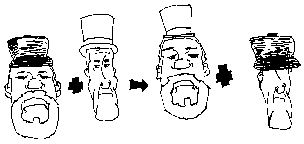What is enthalpy?
Enthalpy is a measure of the total energy of a thermodynamic system. The unit for these calculations is H or ΔH for the change in enthalpy. It is expressed as KJ/mole.
An example of these reactions would be the combustion of propane:
C3H8(g) + 5O2(g) ---> 3CO2(g) + 4H2O(l) - 2220 KJ
ΔH in this reaction can be expressed:
-2220 KJ
1 mol C3H8
-2220 KJ = -444 KJ
5 mol O2 1 mol O2
-2220 KJ OR -740 KJ
3 mol CO2 1 mol CO2
-2220 KJ OR -550 KJ
4 mol H2O 1 mol H2O
Ex. Calculate the energy released when 0.25 moles of H2O is produced.
0.25 moles H2O x -550 KJ = -137.5 KJ -> 1.4 x 10^2 KJ
1 mol H2O
Ex. How man moles of C3H8 is needed to produce 2500 KJ of energy?
2500 KJ x 1 mol C3H8 = -1.126 KJ -> 1.2 moles of C3H8
-2220 KJ
A worksheet:http://www.docstoc.com/docs/70077972/Empathy-Worksheet
Video of enthalpy calculations:
Feb. 16 Endothermic & Exothermic Reactions!!
This is an ENDOTHERMIC REACTION
This is an EXOTHERMIC REACTION
What are endothermic and exothermic reactions?
You can classify them by their prefixes. Endo means "within heating". It describes a process or reaction in which the system absorbs energy from the surroundings. An example of an endothermic reaction would be cracking an instant cold pack. Once you crack it, the pack loses heat and becomes cold instantly. Exo means "outside heating". It describes a process or reaction that releases energy from the system. An example of an exothermic reaction would be an explosion. It releases energy causing the explosion. Most of the time heat is absorbed or released in there reactions.
Energy Diagrams
Both endothermic and exothermic reactions can be shown on energy diagrams. A way to tell if a diagram is endothermic or exothermic reaction is to look at the start and end of the graph. If the end part of the graph is more than the start, it is an endothermic reaction meaning it absorbed energy. If the end part of the graph is less than the start, it is an exothermic reaction meaning it released energy.
Terms:
(a) is the "Activation Energy"
(c) is ΔH or change in enthalpy. It is the change in energy during the reaction. To find this, you can use this equation: Hprod - Hreact.
The one shown above is an exothermic reaction because the reactant's energy is more than the product's energy meaning it released energy.
Terms:
(a) is the "Activation Energy"
(b) is ΔH or change in enthalpy. It is the change in energy during the reaction. To find this, you can use this equation: Hprod - Hreact.
Energy In the Equations
The energy that is absorbed or released can be placed into an equation:
Exothermic reaction in an equation. If the ΔH is negative, it means that reactants lost heat and change into products. :
NaOH + HCl-> NaCl+H20 AH = -57.3 kj
Endothermic reaction in an equation. If the ΔH is positive, it mean that the heat is absorbed and is classified as endothermic reactions:
2C + H2-> C2H2 AH = + 225.9 kj
Here is a site that has a few questions on exothermic and endothermic reactions:
http://www.saskschools.ca/curr_content/chem30_05/1_energy/practice/q2_1.htm
Here is a video showing and explaining the energy diagrams:
Feb. 3 Double Replacement, Combustion, Neutralization
Today's class was going over the double replacement sheet. For those who forget what a double replacement reaction is, it is pretty much self explanatory. It is when When two elements switch places in a chemical reaction. An example would be: NaSOU4+PoBNF2=>PoBOU4+NaSNF2
In this reaction, the NaS and the PoB switched places.
It can be viewed as: reactant+compound+Reactant+compund=Product Compound+Product Compound
We can predict whether a specific single replacement will work. In order to do this, we can use the activity series. This is an table that shoes the order of reactivity of metals and non-metals. Anything higher up the series can replace an ion below it on the table.
A combustion reaction is where burning in the air is involved. The oxygen atoms usually end up combined with more than one type of atom as products. The formula for combustion is: AB + 02 => AO + BO
An example would be: C4H8 + 6O2 -> 4CO2 + 4H20
Neutralization is when a special double replacement reaction where acids react with bases to produce water and an ionic salt as products. The formula for neutralization would be: HA + BOH -> H2O + BA
An example would be 2HBr + Sr(OH)2 -> SrBr2 + 2H2O
Here is a video demonstrating double replacement reactions:
Here is a video demonstrating combustion reactions:
Here is a video demonstrating neutralization reactions:
Subscribe to:
Comments (Atom)








